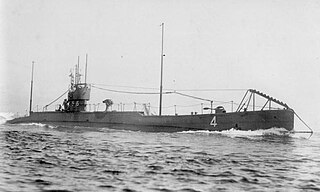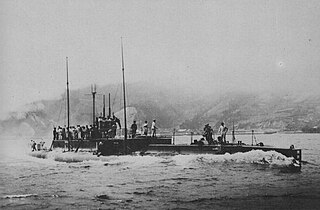Design and description
The submarines of the Type L1 sub-class were copies of the Group 1 subclass of the British L-class submarine built under license in Japan with technical supervision by the British firm Vickers. The Imperial Japanese Navy procured them in order to acquire advanced British submarine technology, as well as the highly reliable Vickers diesel engines that powered the Type L1 submarines. They displaced 907 tonnes (893 long tons) surfaced and 1,092 tonnes (1,075.2 long tons) submerged. The submarines were 70.59 meters (231 ft 7 in) long and had a beam of 7.16 meters (23 ft 6 in) and a draft of 3.90 meters (12 ft 10 in). They had a diving depth of 60 meters (197 ft).
For surface running, the submarines were powered by two 1,200- brake-horsepower (895 kW) Vickers diesel engines, each driving one propeller shaft. When submerged each propeller was driven by an 800-shaft-horsepower (597 kW) electric motor. They could reach 17 knots (31 km/h; 20 mph) on the surface and 10.2 knots (18.9 km/h; 11.7 mph) underwater. On the surface, they had a range of 5,500 nautical miles (10,200 km; 6,300 mi) at 10 knots (19 km/h; 12 mph); submerged, they had a range of 80 nmi (150 km; 92 mi) at 4 knots (7.4 km/h; 4.6 mph).
The submarines were armed with six internal 450 mm (18 in) torpedo tubes — four in the bow and two mounted athwartships and firing on the broadside — and carried a total of ten Type 44 torpedoes. They were also armed with a single 76.2 mm (3 in) gun deck gun.
Service history
Upon commissioning, Submarine No. 25 was attached to the Yokosuka Naval District. [1] On 30 November 1920, she was reassigned to Submarine Division 3, which in turn was assigned to Submarine Squadron 1 in the 1st Fleet on 1 December 1920. [1] Submarine Division 3 was reattached to the Yokosuka Naval District on 1 December 1921 and was assigned that day to the Yokosuka Defense Division, [1] then was reassigned on 1 June 1922 to the Ominato Defense Division. [1]
On 1 December 1922, Submarine No. 25 was attached to the Kure Naval District and reassigned to Submarine Division 11, in both of which she remained for the rest of her active career. [1] During the years that followed, Submarine No. 25 was assigned to the Kure Defense Division from 1 December 1922 to 1 December 1923, was renamed Ro-51 on 1 November 1924, and had additional Kure Defense Division assignments from 1 December 1926 to 10 December 1928, from 30 November 1929 to 15 October 1931, and from 1 December 1932 to 8 October 1935. [1] On 9 April 1938 she and her division mate Ro-53 got underway from Sasebo, Japan, for a training cruise in southern Chinese waters, which they concluded with their arrival at Kīrun, Formosa, on 14 April 1938. [1] [2]
Ro-51 was decommissioned and placed in the Fourth Reserve in the Kure Naval District on 15 December 1938. [1] The Japanese struck her from the Navy list on 1 April 1940, [1] and that day she became a stationary hulk with the name Haisen No. 10. [1]
Ro-52, originally named Submarine No. 26, was an Imperial Japanese Navy Type L submarine of the L1 subclass. She was commissioned in 1920, sank accidentally in 1923 and again in 1925, was refloated and repaired each time, and was decommissioned in 1932.
Ro-53, originally named Submarine No. 27, was an Imperial Japanese Navy Type L submarine, the lead unit of the L2 subclass. She was in commission from 1921 to 1938.

Ro-54, originally named Submarine No. 28, was an Imperial Japanese Navy Type L submarine of the L2 subclass. Except for a few months in 1926, she was in commission from 1921 to 1938.
The first Ro-55, originally named Submarine No. 29, was an Imperial Japanese Navy Type L submarine of the L2 subclass. Except for a few months in 1926, she was in commission from 1921 to 1938.

The first Ro-56, originally named Submarine No. 30, was an Imperial Japanese Navy Type L submarine, the final unit of the L2 subclass. Except for a few months in 1926, she was in commission from 1922 to 1938.
Ro-57, originally named Submarine No. 46, was an Imperial Japanese Navy Type L submarine of the L3 subclass. Except for a few months in 1938, she was in commission from 1922 to 1945. During World War II, she served on second-line duties in Japan.

Ro-58, originally named Submarine No. 47, was an Imperial Japanese Navy Type L submarine of the L3 subclass. She was in commission from 1922 to 1945. During World War II, she served on second-line duties in Japan.
Ro-59, originally named Submarine No. 57, was an Imperial Japanese Navy Type L submarine of the L3 subclass. She was in commission from 1923 to 1938, in 1939, and from 1941 to 1945. During World War II, she served on training duties in Japan.
Ro-26, originally named Submarine No. 45, was an Imperial Japanese Navy Kaichū-Type submarine, the lead unit of the Kaichū IV subclass. She was in commission from 1923 to 1938 and from 1939 to 1940.
Ro-27, originally named Submarine No. 58, was an Imperial Japanese Navy Kaichū-Type submarine of the Kaichū IV subclass. She was in commission from 1924 to 1937.
Ro-28, originally named Submarine No. 46, was an Imperial Japanese Navy Kaichū-Type submarine of the Kaichū IV subclass. She was in commission from 1923 to 1938 and from 1939 to 1940.
Ro-23, originally named Submarine No. 41, was an Imperial Japanese Navy Kaichū-Type submarine of the Kaichū III subclass. She was commissioned in 1923 as the final unit of the Kaichu' III subclass and operated in the waters of Japan, Formosa, and Chōsen before she was stricken in 1935.
Ro-22, originally named Submarine No. 40, was an Imperial Japanese Navy Kaichū-Type submarine of the Kaichū III subclass. She was commissioned in 1922 and operated in the waters of Japan. She was stricken in 1934.
Ro-21, originally named Submarine No. 39, was an Imperial Japanese Navy Kaichū-Type submarine of the Kaichū III subclass. She was commissioned in 1922 and operated in the waters of Japan. She was stricken in 1934.
Ro-20, originally named Submarine No. 38, was an Imperial Japanese Navy Kaichū-Type submarine of the Kaichū III subclass. She was commissioned in 1922 and operated in the waters of Japan. She was stricken in 1934.
Ro-18, originally named Submarine No. 35, was an Imperial Japanese Navy Kaichū-Type submarine of the Kaichū III subclass. She was commissioned in 1921 and operated in the waters of Japan. She was stricken in 1936.
Ro-17, originally named Submarine No. 34, was an Imperial Japanese Navy Kaichū-Type submarine of the Kaichū III subclass. She was commissioned in 1921 and operated in the waters of Japan. She was stricken in 1936.
Ro-13, originally named Submarine No. 23, was an Imperial Japanese Navy Kaichū-Type submarine of the Kaichū II subclass. She was commissioned in 1920 and operated in the waters of Japan. She was stricken in 1932.

Ro-11, originally named Submarine No. 19, was an Imperial Japanese Navy Kaichū-Type submarine of the Kaichū I subclass. She and her sister ship Ro-12 were the first submarines built to a fully Japanese design. She was commissioned in 1919 and operated in the waters of Japan. She was stricken in 1932.
Ro-12, originally named Submarine No. 20, was an Imperial Japanese Navy Kaichū-Type submarine of the Kaichū I subclass. She and her sister ship Ro-11 were the first submarines built to a fully Japanese design. She was commissioned in 1919 and operated in the waters of Japan. She was stricken in 1932.





